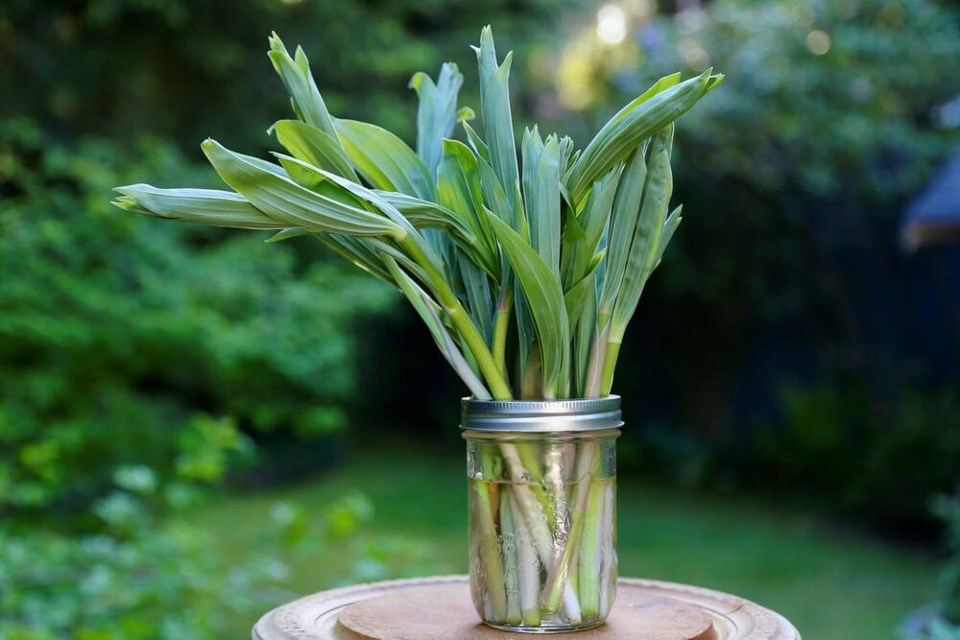The April showers that we experienced this May have been kind to our rain garden, encouraging cool-and-damp-loving native plants to expand their territory.
The beautiful perennial woodland herb, false Solomon’s seal, Smilacina racemosa, seems particularly happy, and is, I learned recently, uncommonly delicious. The asparagus-like shoots that is – blanched ever so quickly in sea-salted water, and then drizzled with olive oil and dried sumac.
Our false Solomon’s seal is quite at home in the cool damp, shaded by highbush cranberry, snowberry, sword ferns, bleeding heart and wild ginger.
The rain garden is young, coming into its own this third summer, but already inhabitants are increasing their territory, spreading laterally into the thick moss carpet that delineates the now-abandoned fairy forest.
False Solomon’s seal is slow to germinate, and unlike its look-alike cousin Solomon’s seal, does not takeover seemingly overnight via a vast underground network of rhizomes. In two of our south-facing gardens, true Solomon’s seal has taken hold, and were it not for our veggie dog Dave devouring the young shoots each spring, I am sure that we would be over-run.
I am confident that over time the false Solomon’s seal in the shady rain garden will spread far and wide enough to provide a few handfuls of tender shoots each spring, and in fall large clusters of ruby-red berries to save for seeds, and enrich winter braises with molasses-like sweetness.
Until then, we can support responsible foragers and wild food vendors like Wild Foraged at local farmers’ markets who practice and proselytize restraint in harvesting wild things. We can learn from them, season to season, and week by week, which wild foods our changing climate can support, and in turn how we can help support them.
Wild foraged foods, like produce grown at home in healthy, organic, living soil, provide phyto-chemicals (plant nutrients) that we co-evolved alongside, and require for good health. It was a privilege this past week, to feast on wild foraged false Solomon’s seal, and wild line-caught salmon. Without question we could taste and feel the goodness, and the wild.
False Solomon’s seal is hardy to Zone 4, and is an important food and medicinal plant for Indigenous people across Canada. Descriptions of the plant and its uses appear in historical records and archives, as well as in dozens of native plant books. As yet, I have been unable to find its indigenous names, but I have run across several references to its use (rhizomes, shoots, berries) in ceremony, winter stores and traditional medicine.
False Solomon’s seal enjoys a cool, shady and moist soil, but prefers not to stay wet. It will tolerate but not necessarily thrive in a sunny location, as long as the soil remains moist. The true Solomon’s seal in our sunny gardens grows up through a carpet of sword ferns and deep moss, which together act like a living mulch through the hottest and driest of summer days.
Both true and false varieties have single long stems with alternate elliptic leaves. False Solomon’s seal is slighter, however, in all things, and seems to prefer more spacing between stalks. The flowers and berries, conversely, are entirely different in appearance and habit, which makes identification easier, at least beyond the early spring shooting stage.
False Solomon’s seal displays a single cluster of tiny white flowers (red berries) at the end of each stem, while the true version displays a bleeding heart-like display of larger blossoms (purple berries) along the bottom of each stem.
Always access field guides and permission before foraging.
Laura Marie Neubert is a West Vancouver-based urban permaculture designer. Follow her on Instagram @upfrontandbeautiful, learn more about permaculture by visiting her Upfront & Beautiful website or email your questions to her here.
For a taste of permaculture, watch the video below:




